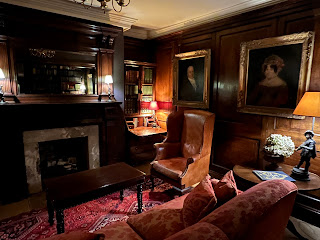October 5, 2024
Our Uber crunched across gravel and pulled up in front of an impressive stone façade. Immediately, two men in button-down shirts and tweed vests rushed to relieve us of our hated, monstrous bags.
“We insist!” said one man, and a tug of war ensued as we sought to wrest our suitcases away from him.
“Please! You’ll hurt your back!” I said.
“We are used to this, really!”
When I loosened my grip and turned to thank the Uber driver, my attention diverted for but a moment, the men and our bags disappeared.
Resigned, Dave and I followed, grinning at the vision before us as we left the brightness of day to enter the dimly lighted front hall of The Lygon Arms. The small bags still in our care rattled over the stone floors as we passed the first of several parlors. Inviting it was with its leather wing-backed chairs and massive fireplace darkened by 700 years of smoky fires, and already I pictured myself ensconced there with a book.
After check-in, Sophie - lithe, blond, and dressed in black - led us up a flight of stairs, down a hall, through a glassed annex, up four stairs and down another hall to our room where our suitcases awaited. Lord, we were glad we hadn’t made that circuitous trip with them. Those poor men.
We unpacked and Dave hopped into the shower while I perused the inn’s history on an electronic tablet. How odd to snuggle in this ancient inn against a comfy headboard upholstered in plaid woolens scrolling for info about dinner reservations on a modern device.
The matching curtains were of soft, heavy wool in shades of lichen and forest green, and a wingback chair with brass studs graced the corner. Until I scrolled further, I was mystified by the decorative decision to place on the bureau a large white rabbit sitting high on his haunches. All was clear when I learned the original name of the inn was The White Hart.
October 6
Careful to avoid horse droppings and muddy puddles, Dave and I followed a footpath worn through the green of a well-grazed meadow. Black-faced sheep with blue swatches on their nubbly wool gave us passing notice, while horses and cows further along paid no heed. At various points, we fiddled with ingenious wooden gate systems that kept the animals in their respective fields while allowing us through. Pauses to absorb our surroundings granted sweeping views of the dirt path we had trod, swaths of pasture, a stately stone church tower, and the village of Broadway beyond. Long have I wanted to wander in a scene such as this…
So, why was I wallowing in worry?
Yes, despite the gentle wind, chirp of birds, and languid flick of a horse’s tail, I was rumbling about in my head, brooding about catching the Eurostar train from London to Brussels in two days.
Dave would have thought I was crazy if he knew how many nights this had kept me awake. I thought I was crazy too: making train connections throughout the trip had put a pit in my stomach ever since we made the arrangements. As distant church bells tolled, clamoring for attention, I chided myself, and sought to shake it off.
We had climbed a long but gentle slope, and it was nearing lunch time. As I stepped around a pile of manure and angled to avoid a clump of thorny thistles, I commented that a comfy seat in a pub sounded pretty good. “Let’s go a little further,” said Dave. “I think the trail skirts the edge of the field and loops back on the other side of that hedgerow.”
Neither of us had any idea what the path might do, or even if the close-packed bushes were a hedgerow, but we continued walking until we encountered some hikers who told us the trail headed back after an abandoned farm.
We pushed on, lifting latches, winding through gate mazes, and noting the “Cotswold Public Way” signs until we came upon a weathered shed beneath the massive dead-white trunk of a tree. Abandoned, yes, long ago, but definitely not a farm. Still, content to grant it that status as reason to turn around, I said, “You’re welcome to keep on, but I’m heading back.”
By then, Dave was ready for a pub too.
Return trips are always faster and easier, and we snapped too many pictures of sheep, cows, and horses along the way, our phones switching to low-battery mode from overuse. When we reached that long, gentle slope toward the end, Dave’s toes and my knees were offended.
“Walk backwards,” I said. Silly as we looked, we turned around and inched our way down the slope backwards… Seriously, we did. And, Cotswold-lesson-learned, it helped.
The village of Broadway is enchanting. Rough walls overgrown with moss and creeping ivy, pink roses blooming in small gardens, whitewashed cottages with exposed beams and thatched rooves. And nestled among all that charm was the perfect welcome after our hike: a pub offering cushioned seats, wine, beer, and fish n’ chips.




















